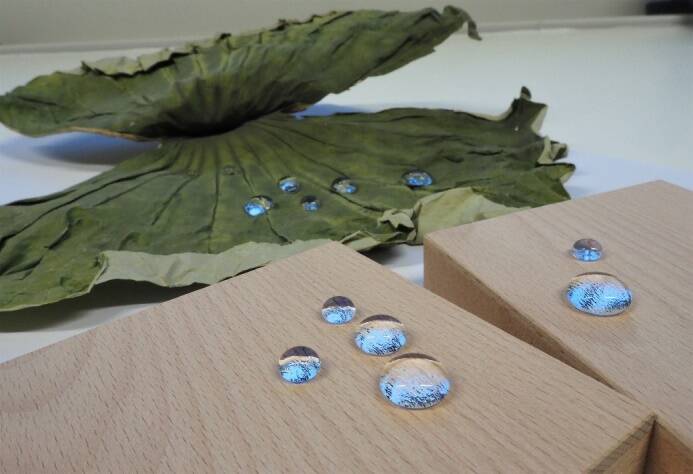
New ways to produce superhydrophobic wood surfaces
Environmentally friendly spraying process prevents unwanted water uptake of wood products by means of the “lotus effect”.
Wood as a renewable, easily available raw material and CO2 storage medium is one of the materials of our future. However, undesired water absorption can cause dimensional instabilities or biological degradation of wood and still limits possible applications. Within the project "New Functions for Wood", a so-called superhydrophobic wood surface has now been developed.
Water forms the smallest possible contact area with such surfaces and thus retains its drop shape instead of wetting the wood. Even at low angles of inclination, the drops seem to "roll" off the surface before they can be absorbed. Lotus leaves have been known for their extremely water-repellent surfaces for thousands of years. Investigations of their surfaces revealed the principles required for superhydrophobicity: materials with low surface free energy, arranged in the form of overlapping micro- and nanostructures. There are countless possible applications but previous developments are often based on hazardous chemicals, are very expensive, and have hardly left the laboratory scale.
Now, a coating has been developed that can transform biobased, originally hydrophilic, i.e. "water-loving" substances such as wood and paper into superhydrophobic materials. Wax particles dispersed in pure water are sprayed onto the surfaces and – depending on the wax used – remain on the surface as complex structures after drying.
Impact and effects
Particularly new is the combination of harmless materials including the use of water as a continuous medium, the simple application method and the cost-effectiveness of the process. The spray process offers all the prerequisites for being able to coat even large wooden components efficiently and continuously. The process works on both coniferous and deciduous woods and is conceivable for a wide variety of indoor and outdoor applications, which is why it has already been registered as a utility model with the Austrian Patent Office. The award-winning development has been very popular at international conferences across all industries. In October 2019, it was also presented at the Young Researchers' Programs of the highly acclaimed Marcus Wallenberg Award ceremony in Stockholm, which is considered the unofficial Nobel Prize for forestry and wood industry. The application created strong interest from leading companies in the timber construction industry, who are actually in contact with the Center.
Together, they aim to solve the general problem of all superhydrophobic surfaces: the mechanical instability of nanostructures, which currently limits their use to short-term applications.





